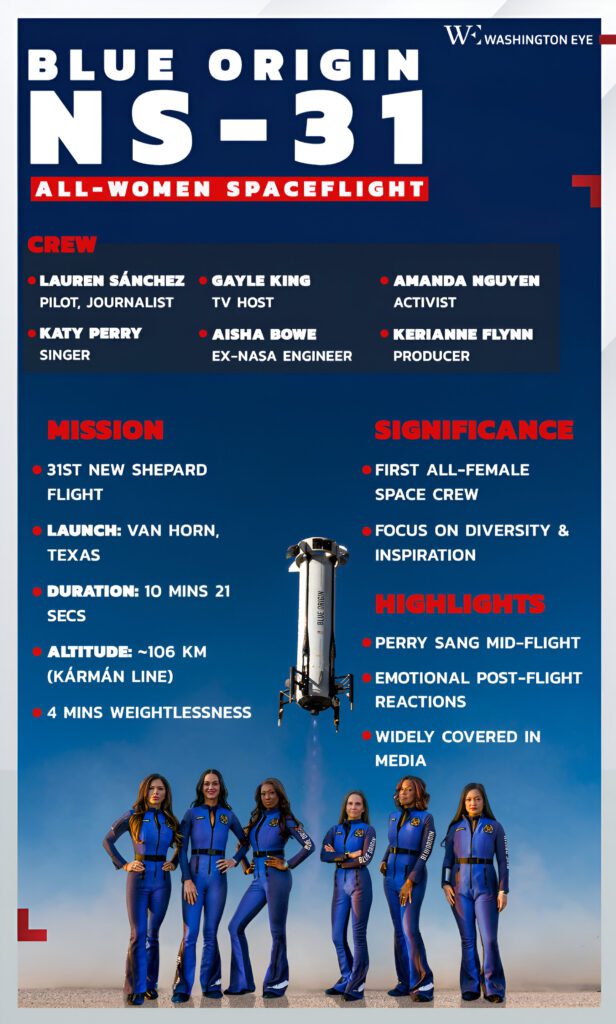On 14 April 2025, Blue Origin’s New Shepard NS-31 mission lifted off from Corn Ranch in West Texas, marking what many hailed as a historic moment: the first all-female crewed mission to space since Valentina Tereshkova’s groundbreaking solo flight in 1963. But amid the celebration, the mission has also sparked debate over the true accessibility and purpose of commercial space travel in the modern era.
The suborbital flight, lasting approximately 10 minutes and 21 seconds, carried six women aboard—a diverse group comprising former NASA aerospace engineer Aisha Bowe, civil rights activist Amanda Nguyen, journalist Gayle King, pop superstar Katy Perry, film producer Kerianne Flynn, and pilot and broadcaster Lauren Sánchez, who is also the mission’s curator. The spacecraft soared beyond the Kármán line—106 kilometres above Earth—offering the crew a few weightless minutes before descending safely back to Earth under parachutes.
Each crew member brought with her a distinct narrative. Bowe became the first Bahamian in space; Nguyen, a Nobel Peace Prize nominee and advocate for sexual violence survivors, made history as the first Vietnamese-American woman in space. King overcame her well-documented fear of flying, Perry brought international celebrity attention to the launch, Flynn championed the role of women in film and storytelling, and Sánchez leveraged her aviation experience to coordinate the mission’s message of empowerment.
Once weightless, the crew declared, “Take up space,” as a unifying slogan, with Perry serenading the cabin with “What a Wonderful World.” Their flight was attended by a host of celebrities, including Oprah Winfrey, who celebrated King’s participation, and Orlando Bloom, Perry’s partner.
What Did This Mission Really Accomplish?
While Blue Origin lauded the flight as a milestone for representation and inspiration, critics have questioned its actual significance. Unlike orbital missions that conduct scientific experiments or contribute to space station logistics, NS-31 was purely touristic—lasting barely over ten minutes. The mission did not carry research payloads, technological tests, or humanitarian goals beyond symbolism.
For some, the symbolism is meaningful—showcasing diverse women in a domain long dominated by men. For others, it’s a reminder that space, at least for now, remains the playground of the ultra-wealthy. With tickets costing hundreds of thousands of dollars, the average citizen is far from “taking up space” in any literal sense. Even among private citizens who’ve travelled to space, most come from elite circles of wealth, influence, or celebrity.
Backlash and “Tone-Deaf” Optics
The presence of Katy Perry on the mission drew particular scrutiny—not only because of her fame, but due to a post-flight moment that quickly went viral. Upon exiting the capsule, Perry was seen kissing the ground. While intended to be a gesture of gratitude, it was widely criticised online as performative and out of touch. Many on social media argued that her behaviour trivialised the accomplishment and reflected a lack of awareness of broader global issues, including poverty, war, and climate crises.
Actress Olivia Munn added to the critique, calling the mission “indulgent” and “tone-deaf” given the world’s current struggles. She questioned whether such ventures truly serve humanity or merely stroke the egos of those wealthy enough to afford a seat.
The controversy surrounding Perry also reignited debates about the optics of celebrities participating in what are framed as inspirational missions. While the intention may be to democratise space, the reality—obvious to many observers—is that access remains limited to those with the right bank account or connections.
A Step Forward or a Missed Opportunity?
Despite the criticism, the NS-31 mission remains notable for its emphasis on gender representation and public visibility. It proved that female-led missions can capture global attention and inspire a new generation of space enthusiasts. But whether that inspiration translates into real progress toward inclusive access to space remains to be seen.
For now, missions like NS-31 exist in a grey zone—caught between progress and privilege. While they undeniably advance the visibility of women in spaceflight, they also highlight the economic exclusivity still inherent in the sector. Until tickets are accessible to scientists, educators, and citizens without celebrity or corporate backing, the dream of universal space travel remains aspirational, not actual.
As Blue Origin prepares for its next flight, the world will be watching—both to see who gets to go, and what they choose to do with their moment among the stars.


















